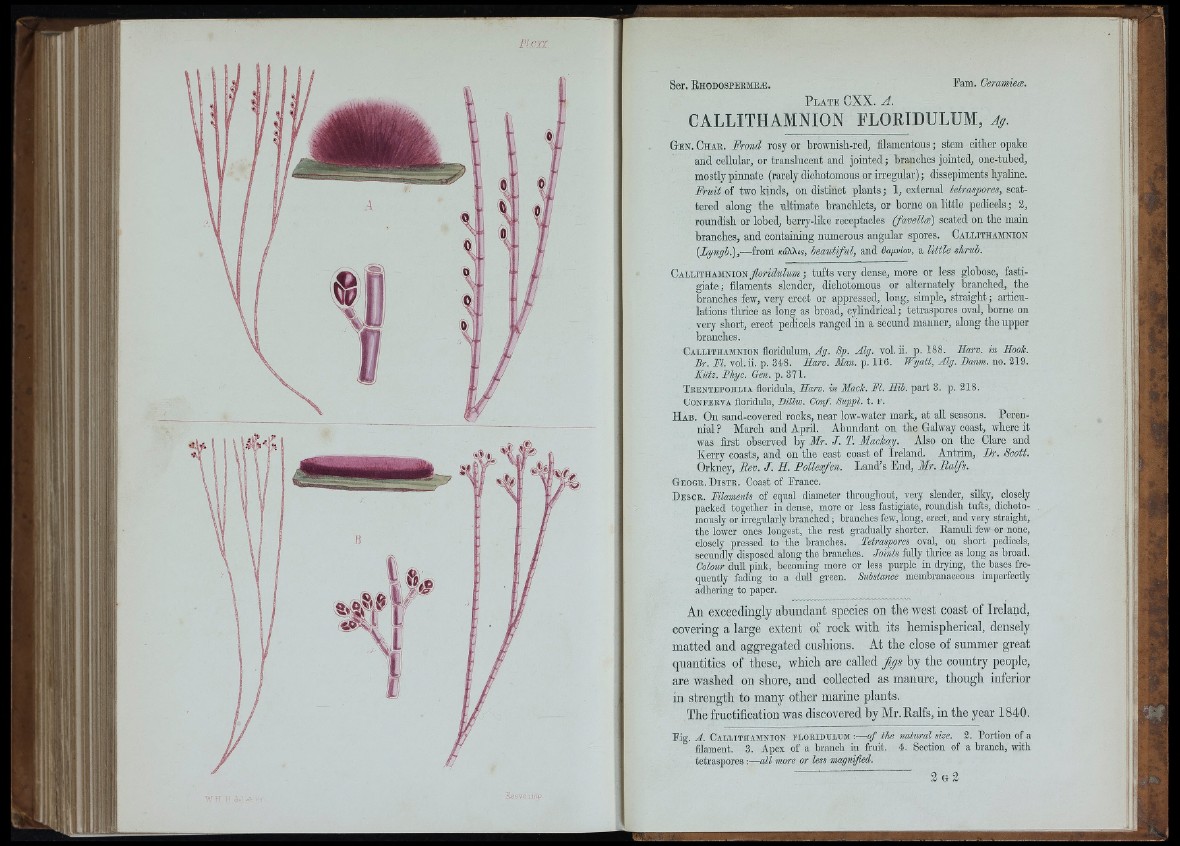
Flcxx.
'ArH ;i ->
Ser. R hodospebmeæ. Fam. Ceramieæ.
P l a t e CXX. A.
CALLITHAMNION FLQRIDULUM, Ag.
Gen. C h ab . Frond rosy or brownish-red, filamentous ; stem either opake
and cellular, or translucent and jo in ted ; branches jointed, one-tubed,
mostly pinnate (rarely dichotomous or irregular) ; dissepiments hyaline.
FrnU of two kinds, on distinct plants ; 1, external tetraspores, scattered
along the ultimate branchlets, or borne on little pedicels ; 2,
roundish or lobed, berry-like receptacles (favellæ) seated on the main
branches, and containing numerous angular spores. C a llith am n io n
[Lyngh),— from toAXîs, beautiful, and bagviov, a little shrub.
Callithamnion/ ori&feiK ; tnfts very dense, more or less globose, fastig
ia te ; filaments slender, dichotomous or alternately branched, the
branches few, very erect or
lations thrice as long as broat
oppressed, long, simple, straight; articu-
d, cylindrical; tetraspores oval, borne on
very short, erect pedicels ranged in a secund manner, along the upper
branches.
Callithamnion floridulum, Ag. Sp. Alg. vol. ii. p. 188. Harv. in Hooh.
Br. FI. vol. ii. p. 348. Harv. Man. p. 116. Wyatt, Alg. Banm. no. 219.
Kiitz. Phyc. Gen. p. 371.
Teentepohlia floridula, Harv. in Made. FI. Hib. part 3. p. 218.
CoNEBKVA floridula, Bilim. Conf. Suppl. t. r .
H a b . On sand-covered rocks, near low-water mark, at all seasons. Perennial
? March and April. Abundant on the Galway coast, where it
was first observed by Mr. J. T. MacJcay. Also on the Clare and
Kerry coasts, and on the east coast of Ireland. Antrim, Dr. Scott.
Orkney, Rev. J. H. Polleafen. Land’s End, Mr. Ralfs.
Geogk. Distb. Coast of France.
Desob. Filaments of equal diameter throughout, veiy slender, silky, closely
packed together in dense, more or less fastigiate, roundish tufts, dichotomously
or in-egulai-ly branched; branches few, long, erect, and very straight,
the lower ones longest, the rest gradually shorter. Eamuli few or none,
closely pressed to the branches. Tetraspores oval, ou short pedicels,
secundly disposed along the branches. Joints fully tlu'ice as long as broad.
Colour dull pink, becoming more or less purple in drying, the bases frequently
fading to a dull green. Substance memhranaceous imperfectly
adhering to paper.
An exceedingly abundant species on tlie west coast of Ireland,
covering a large extent of rock with its hemispherical, densely
matted and aggregated cushions. At the close of summer great
quantities of these, which are called figs by the country people,
are washed on shore, and collected as manm-e, though inferior
in strength to many other marine plants.
The fructification was discovered by Mr.Ralfs, in the year 1840.
Fig. A. Callithamnion plomdulum :—of the natural size. 2. Portion of a
filament. 3. Apex of a branch in fruit. 4, Section of a branch, with
tetraspores ;—all more or less magnijied.
2 g 2
Ii '• I r